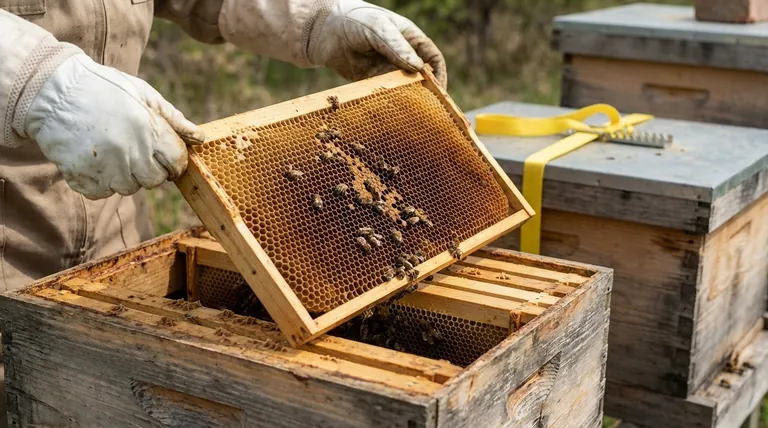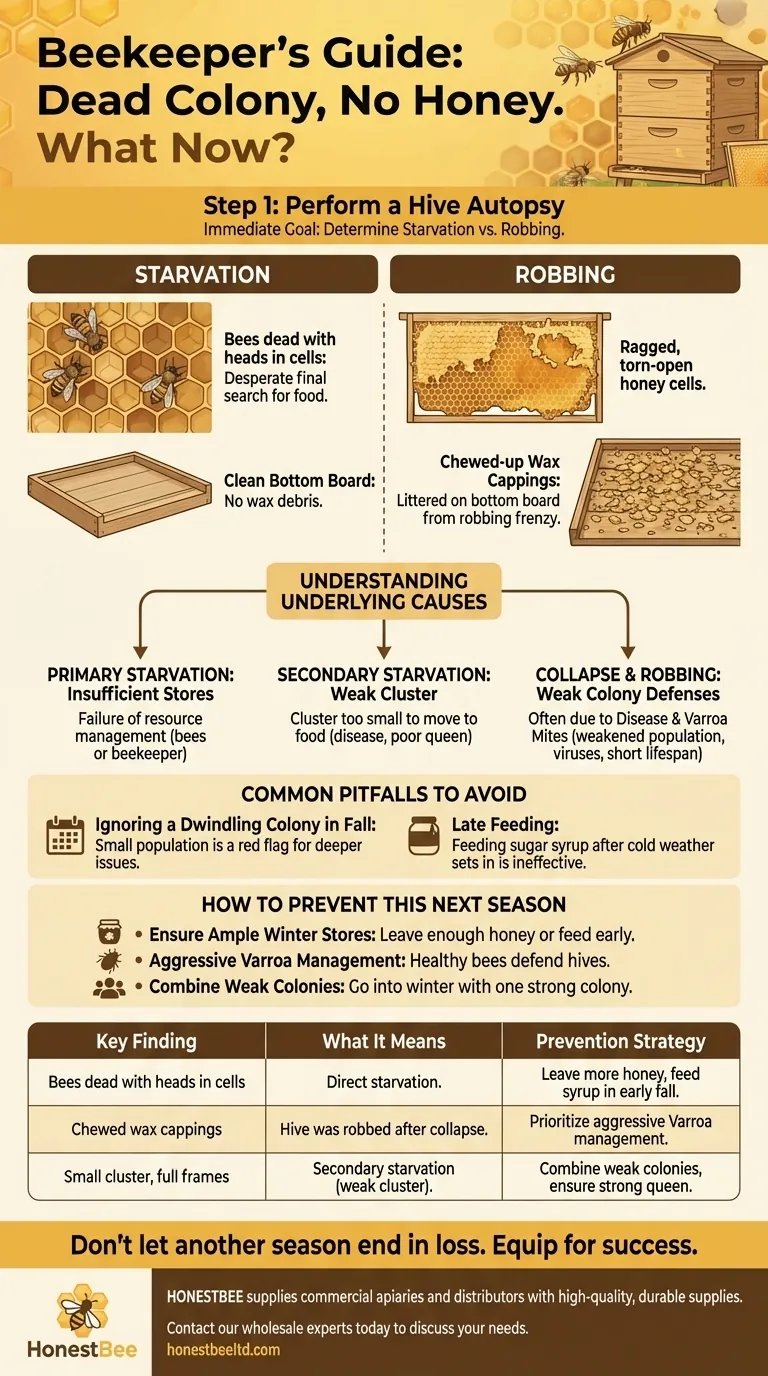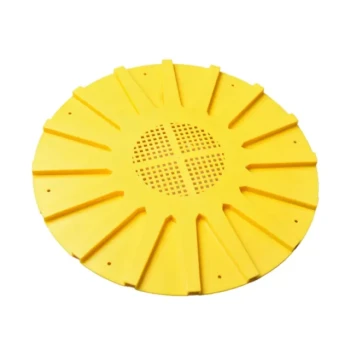The first step is to perform a hive autopsy. When you find a dead colony with no honey, your immediate goal is to determine if the bees starved directly or if they died from another cause and were subsequently robbed of their honey. This crucial distinction dictates your future prevention strategy and is revealed by carefully examining the frames and the bottom board of the hive.
Finding a dead colony without honey is a critical diagnostic event. Your task is not just to clean up, but to read the evidence left behind to understand whether the core problem was a lack of food or a failure of colony health, which will directly inform how you manage your other hives.

Conducting the Hive Post-Mortem
The evidence inside the hive tells a story. By looking for specific signs, you can piece together the final days of the colony and determine the most likely cause of death.
The Central Question: Starvation or Robbing?
A colony with no honey died in one of two ways. It either consumed all its food and starved, or it collapsed from another issue (like disease or a weak population) and its undefended stores were then stolen by bees from other hives.
Look for Signs of Robbing
If a colony died with honey still in the hive, neighboring bees would quickly find and "rob" it. The signs of this are unmistakable.
You will find chewed-up wax cappings littering the bottom board. Robbing bees tear open sealed honey cells, creating a mess of wax flakes that is very different from a clean hive floor. You may also see ragged, torn-open honey cells on the frames themselves.
Look for Signs of Starvation
Direct starvation leaves a different set of clues. The most telling sign is finding bees dead with their heads inside the cells, a desperate, final search for food.
In a starvation scenario, the frames will be bone dry with no remaining honey, and the bottom board will be relatively clean, lacking the significant wax debris associated with a robbing frenzy.
Understanding the Underlying Causes
Once you've determined whether the hive was robbed or starved, the next step is to understand the root cause. A colony's failure is rarely due to a single event but rather a cascade of factors.
Primary Starvation: Insufficient Stores
This is the most straightforward cause. The colony simply did not have enough honey and pollen stored to survive the winter or a period of nectar dearth. This is a failure of resource management, either by the bees or the beekeeper.
Secondary Starvation: A Weak Cluster
Sometimes, a hive has enough honey stored but the cluster of bees is too small to survive. In cold weather, the bee cluster must move together to access new frames of honey. If the population has dwindled due to disease or a poor queen, the cluster may be too small and weak to move, starving just inches away from full honey frames.
The Impact of Disease and Mites
A heavy Varroa mite infestation is a primary driver of winter colony collapse. Mites weaken the bees, transmit viruses, and drastically reduce the colony's population and lifespan.
A colony weakened by Varroa enters winter with a small population and unhealthy bees. This weak cluster is inefficient at regulating temperature and consuming food, making it highly susceptible to secondary starvation and eventual collapse, which then invites robbing.
Common Pitfalls to Avoid
Proactive management in the late summer and fall is the only reliable way to prevent winter losses. Reacting to problems in November is often too late.
The Danger of Ignoring a Dwindling Colony
A small, declining colony in the fall is a major red flag. Do not assume it will "bounce back." A small population is a symptom of a deeper issue, such as a failing queen, disease, or a high mite load. Ignoring it almost guarantees the colony will not survive the winter.
The Mistake of Late Feeding
If a colony has insufficient stores, it must be fed supplemental sugar syrup. However, feeding should be done before cold weather sets in. Bees need warmth and time to properly process the syrup, dehydrate it, and store it in the cells as they would nectar. Feeding cold syrup to a cold colony is an ineffective, last-ditch effort.
How to Prevent This Next Season
Use the lessons from your deadout to build a stronger management plan for the future.
- If you suspect direct starvation: Focus on leaving enough honey for the bees after your harvest. Be prepared to feed colonies supplemental syrup in the early fall to ensure they have ample winter stores.
- If you found signs of robbing (or suspect disease): Your priority must be aggressive and timely Varroa mite management. Healthy, mite-free bees are the foundation of a colony strong enough to defend itself and survive winter.
- If you suspect the winter cluster was too small: Evaluate your queen's performance and combine weak colonies in the fall. It is far better to go into winter with one strong, populous colony than two weak ones.
Every lost colony provides a lesson that makes you a more resilient and successful beekeeper.
Summary Table:
| Key Finding | What It Means | Prevention Strategy |
|---|---|---|
| Bees dead with heads in cells | Direct starvation. The colony consumed all its food. | Leave more honey after harvest; feed supplemental syrup in early fall. |
| Chewed wax cappings on bottom board | The hive was robbed after the colony collapsed. | Prioritize aggressive Varroa mite management for healthy, defensible colonies. |
| Small cluster, full honey frames | Secondary starvation from a weak, immobile cluster. | Combine weak colonies in fall; ensure strong queen performance. |
Don't let another season end in loss. The evidence from a dead colony is a powerful tool for improving your apiary's resilience. A strong colony starts with the right equipment and management practices. HONESTBEE supplies commercial apiaries and beekeeping equipment distributors with the high-quality, durable supplies needed to build and maintain healthy hives. Let us help you equip your operation for success.
Contact our wholesale experts today to discuss your needs and build a stronger season ahead.
Visual Guide

Related Products
- Professional Galvanized Hive Strap with Secure Locking Buckle for Beekeeping
- Versatile Ratchet Hive Strap with S-Hooks for Secure Fastening
- Heavy-Duty Galvanized Steel W-Style Pallet Clip
- Professional Wide Blade Honey Scraper for Beekeeping and Honey Processing
- Endless Loop Ratchet Hive Strap
People Also Ask
- What are the types of Emlocks available? Choose the Right Strap for Hive Security
- How should a cam buckle strap be installed for optimal performance? Master the Leverage for Maximum Tension
- How can beekeepers secure the top cover of a hive? Protect Your Colony from Wind and Weather
- What are the two styles of hive straps? Choose the Right Strap for Your Hive Security
- What is the advantage of using cam buckle straps? Secure Your Load Fast with Simple, Safe Tensioning



















